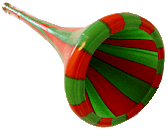 |
(v1.0)
How
to make
|
 |
 |
(v1.0)
How
to make
|
 |
But from hornet to hornist it takes only a few steps, so let me explain in this little FAQ how to make less annoying tones on the vuvuzela and turn it into a pleasant sounding musical instrument. (I am not affiliated with manufacturers of blowing horns or any other company's brand names mentioned on this page.)
An obvious approach for making vuvuzela music is of course to blow tuned vuvuzelas of different lengths in a group using one horn per note (like the Russian Horn Capella - basically forming a human pipe organ). Although this is a good method to play very loud or with barely trained musicians (plus a conductor), the concept is way too establishment since it grossly underestimates the capabilities of the vuvuzela, so I won't discuss this further here. (If you want to play like this, check the Vuvuzela Orchestra link below.)
Compared with modern brass instruments vuvuzelas appear primitive, so even trumpeters often doubt that it is suited for melody play since it looks to them more like a joke article and especially needs different play techniques than taught in most music school's trumpet lessons. But even though some brass players get angry about calling this cheaply mass produced plastic object a "trumpet", in a nutshell it is (or more precisely a predecessor known as "herald trumpet", "straight baroque trumpet" or "straight lur"). At least it is the closest you can get to a trumpet for few euro. It is a natural blowing horn that (much like a post horn or alpenhorn) can play many different pitches and not only toot a single very loud note.
E.g. there is the Vuvuzela Orchestra and the Rainbow Vuvuzela project (both are also on YouTube).
No matter how many people hate the vuvuzela so much that they feel stung in their ear and would swat a bee flat to kill that unmelodic B flat hornet buzz in stadiums, definitely positive is that the wide spread of this cheap or free plastic thing in households will make many additional people train to blow a lip operated (embouchure) wind instrument those else would never come in mind or get the occasion to try them. So the apparent commercialized plastic annoyance may set the basis for a new generation of brass and horn players; only future will reveal how many musicians will proudly tell that they discovered their talent on a found plastic lur.When people first time try out a vuvuzela, they tend to look at the
mouthpiece, see the hole, blow some air into it and surprisedly listen
what happens: "pfffff pfffffff..." - nothing! Slowly noticing that this
is obviously more than one of those toy party horns, the next they typically
do is reading either an instruction sheet (if present) or look for help
on vendors websites. And there they usually find something stupid like
"Close your lips and blow through them to make them vibrate with a farting
noise. Squeeze the mouthpiece against them and BLOOOOOWWWWW as strong as
you can..." And after the vase is broken, the wall clock stands still and
the last shard of the fallen chandelier has stopped rolling around on floor,
you can stop blowing now... ;-) Although that tip may help
to toot loudly, it is useless for melody play, thus it is best to forget
this for now and try something else. Also the common establishment's claim
that one can anyway blow only about 3 different notes on such a short horn
only refers to a certain type of very loud signal tones and deserves to
be ignored. Claiming that it can't do others is like saying that a skateboard
can not be steered because it has no steering wheel. Already millennia
ago people played melodies on similar instruments, so let's now try what's
possible.
 |
To play well, your lips need to stay moist (but not wet), thus drink enough water or tea and take a sip between play to wet your mouth. Also lip balm may help. Do not use drinks those are sticky or contain calories (e.g. milk ingredients); despite this wind instrument is washable (most others aren't!), spraying drink drips through the mouthpiece into the room or on people can not be fully avoided and may cause mould fungus and other hygienic problems. Also regard that mouth operated wind instruments turn very wet inside after play, so do not store it in wet state in closed cabinets or boxes to avoid moisture damage and watch out not to drip spit and water out of its bell on papers etc. For hygiene I recommend to wash the plastic instrument after use and towel it dry.
Hum with your voice the notes you want to play and close your lips to make them vibrate by your voice. Blow during this to make the note sound louder and adjust your lip tension until it sounds clean and trumpet- like (similar like blowing on comb and paper or a kazoo). Hold the mouthpiece gently against the lips until you hear the notes coming out of the vuvuzela. Your voice tone will help to make the air in the instrument oscillate at the intended pitch. This play method works well for low and medium pitch notes. Everyone can play this very easy way.
Make a slow siren tone with your voice and listen how different pitches behave. You may notice that some notes sound clearer than others those have a beat frequency in them; although you can vary this a bit by lip tension and mouthpiece squeeze, you can not make all notes of a chromatic scale sound equally clear. You will also notice that the louder you blow, the less notes sound clear. Don't worry - this is the normal behaviour of this play technique and not least of a natural trumpet or lur (which the vuvuzela essentially is) and the reason why modern trumpets have keys and trombones have a slide. The timbre is less bright than a brass trumpet and resembles a cross between a bugle and a drain pipe; some notes will always have a beat in them or sound snotty, but that's what this archaic type of instrument sounds like. Have fun and don't take timbre quality issues to serious; this sound turns the time of blowing horn inventions back by a few thousand years.
tip: For a novice it can be hard to distinguish how he is producing a tone. To check how you are buzzing, touch the front of your lips with a finger; when the tone stops, you buzz with lips rolled in while when the pitch increases, you are buzzing unrolled (with pout, a trumpeter by BbTrumpet.com on YouTube called this "buzzing inside the aperture tunnel"). When the tone stops completely by touching only one lip, then only that lip vibrates and the other stands still which wastes 50% of sound pressure, thus it is better to position them in a way that both lips vibrate.
The pitch is controlled by lip muscle tension; squeeze tighter to make the tone higher, blow stronger to toot louder. Also moving the lower lip (and jaw) back and forward changes the pitch and accessible octave range; when it sounds snotty (like blowing one's nose or roaring racing car buzz) you are likely out of that range, thus readjust your lower lip for different octaves. (With me I have to move my jaw back for lower notes.) More technically explained, the pitch is controlled by the horizontal width of the vibrating gap (aperture) between the lips. The aperture is roughly rhombic; raising the pitch squeezes this opening narrower from both sides by muscle tension, which makes the section shorter (much like a finger on a guitar fretboard shortens the vibrating section of a string) and so increases the frequency. Although this is hard to see in a mirror and a little unobvious, it can help to get an idea what the muscles actually do and how to change the tone. When you roll the lips too much, the tone will be sweet but very soft; when rolled too little, the tone turns harsh and becomes hard to control (sounding like a penguin when multiple apertures appear and vibrate in a kind of chorus effect), so it can takes a while to find a good intermediate position. The sweet and soft tone by rolled lips has a singing quality that (especially with tongue forward) often resembles more a clarinet than a trumpet, so I am not sure how far this corresponds to the mythical "clarino" blowing technique that was forgotten by trumpeters soon after the valve trumpet was invented and so lead to the invention of the clarinet. In baroque era the art of clarino play was said to be very difficult to master; I particularly notice that this timbre extremely changes with the actual lip condition which makes it hard to use reliably. Placing the tongue tip near the lips (which was a key element in clarino blowing) makes the timbre thinner, brighter and hollower and also raises the pitch a bit. To play a breathy tone (soft with wind noise) squeeze the lips less (making the gap vertically higher while keeping the width) and blow more air through them. Blow the start of each note with mouth muscles, not lungs; lungs respond too slow and rather cause dizziness. How ever you may combine both by learning circular breathing (blowing air out of the mouth with mouth muscles while refilling the lung through nose) to blow endless tones. To blow percussive staccato, move you tongue like saying "ta ta ta ta" or "ta ka ta ka". For fast tremolo form a rolling "rrrr" in your throat, for slow tremolo a "la la la la". With such simple tricks you can sound spectacular without much effort. When blowing through the instrument, the exact mouthpiece position and squeeze is important to make a clean tone: with me it works best (especially with bass notes) to touch the mouthpiece mainly with the upper lip while the lower vibrates freely. As an easy way to play vibrato, rattle the mouthpiece on your lips quickly back and forward.
caution: Avoid to inflate your cheeks fully, or you may hurt your salivary glands or ears and finally end up looking like Dizzy Gillespie. Use cheek muscles to keep cheeks at least halfway in; you don't need to blow with high pressure to make a tone. Also do not press the mouthpiece too firmly against your lips to avoid bruises; especially for high notes you don't need to press at all, but only treat it like a close microphone (same technique like blowing on a jug). Pressing should be only used to play vibrato but not to raise pitch permanently. Certain cheap vuvuzelas have a sharp edged mouthpiece rim that can hurt your lips, thus sand it off before use.
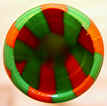 Mouthpiece
with rough plastic rim.
Mouthpiece
with rough plastic rim.
Don't worry if you can't control the pitch at all during the first hour of practising. This is like learning not to tip over on a bicycle. Some hours or days later you will likely discover that it suddenly works much better because your brain needs time to reconfigure itself for this special type of lip control. Thus do not practise too long but meditate or sleep over it before you continue. Generally it can be hard to blow high notes for more than few minutes due to lip and cheek muscle exhaustion (it stresses them like a tense extreme grin). Like other muscles, also these will turn stronger by repeated training; e.g. blowing very soft long tones is known to increase endurance. The lip buzzing is a standard training exercise of brass players, so trumpet websites may help you, but unlike a real trumpet mouthpiece, the frequency change by interaction between lips and vuvuzela is much weaker, so the play technique much rather corresponds to free buzzing without horn than playing the (modern) trumpet itself. On YouTube are plenty of trumpet lessons with lip buzz instructions. Much like a theremin, the general play technique of the vuvuzela is very easy to learn but precise pitch control is hard to master on a professional level. But it takes only few days to learn to blow recognizable melodies, so do not give up if you think you can't.
Also regard that although lips need moisture to stay flexible enough to play, the paradox is that this blowing technique only works well when the lip surface is fairly dry; it turns almost impossible after eating anything smeary or having the lips soaked in a drink, because this makes their surface too sticky (and heavy?) to vibrate fast enough, which results only in a farting noise. Even a too thick layer of lip balm or lipstick may disturb and also blowing too long without pause seems to moisten the lips too much for high notes. Blowing too long or with too wet lips also can make your lip skin rough and cracked. If you have a shred of loose dry skin on your lips, do not tear or coarsely bite it off when you intend to play; the resulting sore surface will be too moist to blow high notes for many hours. Instead simply make a finger wet and gently rub it off. (You may also carefully cut off only the protruding loose rim of the skin shred with a nail scissor when you need to avoid wet lips to play immediately.) Horns are called "horns" because blowing them makes lip skin horny ;-) (isn't it?), but a thin horny layer even seems to ease play because it helps to keep them dry. Generally dryer lips ease the play of high notes while moister lips make low notes easier. E.g. when I awake in the morning with dry mouth I can easily blow much higher notes than average while I fail to blow low notes. (When low notes fail, quickly moisten your lips by tongue.) Also excessive sweating can make lips too wet. Otherwise lips often need some minutes of warmup play before they sound ok, so don't worry when you fail to tweak the pitch right during the first minute. The control of lip moisture seems to be the most difficult parameter for blowing high notes and certain timbres reliably, which may be a main reason why different mouthpieces and more complex horns were invented. (I can blow high notes only a short time (enough to feed a sequencer), how ever I am no professional brass player, which makes it hard to estimate for me what they can do. Although many arrogantly mock how bad the vuvuzela is, I read that for training they e.g. regularly do melodic lip buzz over 3 or 4 octaves in a controlled way where I start to sound like an elephant. I am quite sure they could do this also on the plastic lur with only a small adjustment of play technique, when they wouldn't fear to look silly or spoil the precious professional image of shiny golden brass instruments.)
The vuvuzela timbre is duller (and less aggressive to the ear) than a "real" trumpet or trombone, because it is conical without cylindrical pipe sections and thus physically rather resembles a bugle; also the lack of brass and sheet metal may be related to it, and not least the primitive mouthpiece. But like a digeridoo, the vuvuzela can make plenty of different timbres by mixing human voice into the trumpet tone. By singing and blowing simultaneously, you can e.g. make sonorous bass sounds resembling a roaring distorted heavy metal guitar or play 2 notes simultaneously. People with experience in human beatboxing will benefit here. Strange is that despite the vuvuzela has no single reeded mouthpiece and is constructed much simpler, the available timbres IMO resemble more a saxophone than trumpet. You may also whistle or flute into the vuvuzela by holding the mouthpiece away from your lips. Making music on this cheap plastic instrument can be a nice way of expressing punk attitude and (unlike the boring ubiquitous plastic recorder flute) is well suited to surprise unknowing people with plenty of unexpected sounds, which e.g. may be used also in clown or comedy performances. No matter how good or bad people may play the vuvuzela - calling this thing a "single note instrument" is as stupid as calling the violin a "four note instrument" because it has only 4 tuned strings.
By installing a plastic pipe or thick garden hose between rear part (with the mouthpiece) and the front part of a vuvuzela you can make it longer. This will not only make the main tone lower, but may also permit to play more notes cleanly because it increases the count of available overtones of a natural blowing horn.
On the internet I saw that some people also cut it shorter (truncate parts of the funnel end) to raise the pitch of the main tone when they intend to blow in a group of different length vuvuzelas only these loud tones for music. But this will also make it harsher, so I would rather recommend to cut out a part from the middle section and reconnect the rest e.g. by a piece of bike innertube or duct tape.
There are also telescopic 2 part vuvuzelas available those were designed to be collapsible to make them easier to carry. However they can be also played with the rear end partially pushed in and the length can be even changed like a trombone slide to vary the tone during play. You may also imitate or extend this mechanism using 2 plastic pipes those loosely fit into each other.
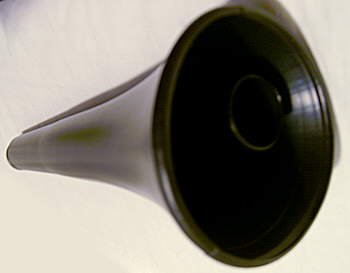 |
 |

the European 3 part Vuvuzela |
 |
remove ring and muffler:
Regard that this mod is permanent and can not be undone. Insert a closed household scissor into the hole and turn it to drill out the plastic ring around the hole. This ring holds the muffler, which is an about 4cm long plastic pipe that reduces the diameter and will fall out once the ring is gone.remove muffler only:caution: Be very careful to deburr the hole well (use the scissor) and wash it thoroughly under tap water to remove all loose plastic shavings to prevent inhaling them accidentally. Use a rolled rag or tissue to wipe away remaining debris if you are not sure.

Simply knock the rear part with its open front on a hard surface or toss it on the floor until the muffler falls out. You may also poke with a pen or stick in the mouthpiece hole to push it out. (You may reinstall the muffler later using a stick if you really want.)Put the vuvuzela back together and sing through it. You will immediately hear the difference. Also holding the mouthpiece at your ear like an ear trumpet will transmit high pitched sounds much clearer with muffler removed.
The design of the European vuvuzela is ridiculously German; it is made from 3 robust and perfectly engineered injection moulded PE plastic segments, and to prevent people from abusing the now sturdy and pretty looking instrument as a truncheon, they added a precise clip mechanism to make it fall apart when hitting hard. Most other plastic vuvuzelas consist simply of so flimsy blown sheet plastic that they would just fold up like a disposable PET bottle when anybody is beaten harder with them, which makes this misuse attempt at least as ineffective. It has even a flag holder like a real herold trumpet, and the European vuvuzela has not only a stylish embossed warning icon not to point at ears and the annoying muffler, but the company Urbas I Kehrberg GmbH even registered the term "Vuvuzela®" as European trademark to fight competitors, despite it seems to be the generic African language word for this kind of instrument and thus in public domain. (This is as sick as the idea of patenting the Australian word "Digeridoo" as exclusive trademark to sell a certain digeridoo brand outside Australia.) To market the thing, they then created a big hype by spreading 1.5 millions of them as consolation prizes in a supermarket chain's scratch ticket lottery (resulting in plenty of kids tooting in the streets, baiting other kids for buying them also), and to complete the marketing coup, they released the perfectly timed propaganda anthem "Salutation Vuvuzela" with videoclip and making-of on YouTube. Although this is a less harmful and money eating hype than Apple's censored iPad and iPhone media platform, the whole campaign reminds me somehow of the propaganda song making from the movie "Wag the Dog".
Due to FIFA complaints during Soccer World Cup 2010 in South Africa, it may be that also other vuvuzela brands will be sold soon only with mouthpiece mufflers. E.g. the manufacturer Masincedane Sport announced that they designed a toned down version that is 20dB quieter.
Another obvious mod to upgrade for easier melody play is of course installing a mouthpiece from a real brass instrument. Although I wouldn't consider this an authentic vuvuzela anymore, trumpet mouthpieces are famous for permitting easier play of high notes with bright timbre even when only plugged into a piece of hose or watering can. Cheap ones cost on eBay about 4 to 15€. Horn mouthpieces have a conical shape for duller timbre. Tuba mouthpieces are designed for blowing low notes, but they are more expensive. Like clothing, mouthpieces are made in different sizes to fit well on the player's lips. Additionally they come in many different shapes to select the timbre and pitch range. If you have a brass allergy (like me), there are also "brass" instrument mouthpieces of other materials available. I am no expert in different mouthpiece types, but there is much info on the internet. For a try I ordered on eBay a trumpet mouthpiece type "7c" made in China (claimed "silver plated" but looks like chromium) because it was cheapest. It easily fits loosely into the mouthpiece of vuvuzelas in a way that only the thick rim protrudes. (To prevent it from falling out, you may make an adapter from soft plastic or rubber tubing to get a tight fit.) What I notice is that blowing through it slightly raises pitch and particularly makes the timbre brighter, louder and thinner. Because the hole is much smaller, talking or singing through it (and sound transmission as an ear trumpet) works poorly. It also complicates blowing a bit because you have to align the lip aperture to blow the buzz exactly through that small hole to get a sufficiently loud tone. IMO the vuvuzela sounds nicer with the original mouthpiece, but at least this is an easy way to get an additional timbre out of it. When used without a horn, the trumpet mouthpiece tone is very thin and resembles a duck call whistle.
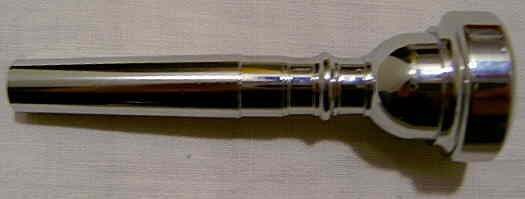
a trumpet mouthpiece type 7c |
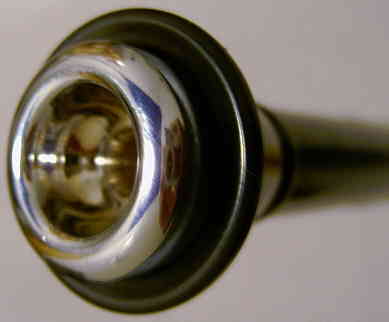 |
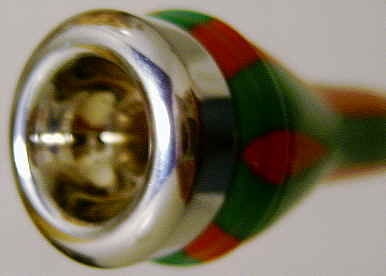 |
Only when I intentionally tooted louder I got 125dBA inside the muzzle and over 90dBA 2m away. A strongman with enough lung power to burst hot water bottles would doubtlessly also be capable to blow this thing with earsplitting vigour across several meters distance.
other plastic horns
But among stadium and party noise makers the vuvuzela is definitely not the most annoying thing. Worst is IMO definitely the canned air horn (which additionally wastes eco-harmful propellant and throwaway cans) followed by any horns with integrated framed free reed or diaphragm mouthpiece. Their high pitched toot usually can not be changed at all and is much more disturbing than the sonorous hum of vuvuzelas. Also thunderer whistles can be really deafening. In a TV documentary some year ago I saw a noise test of an ordinary small party horn (about 15cm small straight paper funnel with single note plastic reed mouthpiece); the shocking result was that this few cent cheap toy could harshly yell at a muzzle sound pressure of over 160dBA(!), which corresponds to a rifle shot and may immediately tear eardrum and inner ear to shreds once a child decides to toot directly into anybody's ear. However the muffler in the European vuvuzela is like riding a racing bicycle with halfway stuck brake to enforce a speed limit; it not only reduces top speed but also makes the whole bike more strenuous to ride and steer at low velocity, thus for musical use it should be removed.
Despite they were certainly not invented for this, on YouTube I saw a jazz musician who indeed managed to play a few different notes even on a diaphragm horn by moving his hand inside the bell. I bought the very similar "The Beat - Horn" by Powco that I find very hard to play this way. Especially it is always very loud because unlike vuvuzelas it refuses to sound at all when blown softer. On the instruction card is even a warning not to honk it indoors.

a diaphragm horn - loud but hard to play melodically |
 |
 |
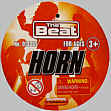 |
But kids can use the instrument once they are educated enough to handle averagely dangerous objects (like scissors or light bulbs) and to understand that loud noise is dangerous and that they must not toot into anybody's ear. The vuvuzela constitutes a nicely simple, inexpensive, lightweight and washable exercise trumpet that is well suited for beginner's school music lessons, musical games, music therapy, breathe exercises and many other things. I yet saw many kids in the streets blowing them despite "not a toy" warning. (In former times kids trumpeted on objects like watering cans or funnels with garden hose instead!) When kids make to much noise or misuse the vuvuzela, parents should lock the instrument away and only give it back for practising under supervision.
On the one hand skilful play on the vuvuzela can be very difficult to master in terms of lip coordination and unobvious play techniques, but on the other hand it is very simple since there are no complicated keys or fingerholes distracting novices or enforcing a predefined tone scale, and unlike a bassoon or cello this is a cheap object that can be bought without serious plans of going further. It is a fun instrument of apparent shocking simplicity combined with a lot of musical potential. From a banal toot up to jazz or beatboxing it opens a far space of possibilities. If you learn to master it, it will certainly help to play a real brass instrument even better, because a vuvuzela allows no cheating; it does not automatically improve a snotty or off-pitch tone by pipe resonance nor ease difficult notes by keys, and even a rough mouthpiece rim can have the educational benefit of preventing or breaking the habit of wrong embouchure techniques those crush lips and will make trouble also on brass instruments. If you can't play it well or think it sounds poor, never forget - the vuvuzela is fun - it was not meant be a perfect wind instrument; it skips all the optimizations modern brasswinds are based on. It's all back to the roots - a conical pipe with a hole at each end. Play it and explore how it sounds.
"Vuvu" means "shower" and the plastic vuvuzela is completely waterproof and constructed so simple that you can easily take it under your shower and wash it with soap water to remove the snot after play, which is a great hygienic benefit over conventional wind instruments. Thus the lack of a detachable mouthpiece is no big problem, not least because the instrument is so cheap that every pupil can get his own.
The waterproofness makes it also very suited for experimental music. You can safely play it with the bell under water to make bubbling tones or blow soap bubbles during play etc. without worry of ruining an instrument.
How ever how far their use in sport stadiums deserves the term tradition is disputed. Critics claim that the plastic version was introduced in South African stadiums not before 1990th and first imported from China. (There are reports that such plastic horns exist in Mexican stadiums since 1970th.) In 2001 the South African company Masincedane Sport started to mass produce their own version. The distributor BoogieBlast claims on its website that the plastic horns were first successlessly sold as toy trumpets before a modified (louder?) version was offered to soccer supporters and that these coined the term "vuvuzela". In early 2010 the religious organization Nazareth Baptist Church (known as Shembe, founded in 1910) attempted to sue plastic vuvuzela makers for compensation, claiming the plastic version was illegally copied from their church's holy horn "izimbomu" which they blow for praise and worship and which originally was made of tin (i.e. pewter?, or sheet metal?). Also the origin of the word "vuvuzela" (that several companies claim to be a trademark) is disputed. In Zulu language it directly translates to "vuvu-ing" where "vuvu" is a slang word for "shower" that may refer to the funnel shape of shower heads or "showering in music" or just mimics the produced sound. Others suggest that the original word was "voodoozela" alluding to similar sheet metal horns blown in Voodoo ceremonies, and that they changed it into something less suggestive to avoid religious complaints. The whole quarrel about attempts of patenting and monopolizing the instrument sounds absurd. Not least we are talking here about the most basic type of a natural blowing horn, and making them of blow moulded plastic was invented already in the era of celluloid toy trumpets. May be that mufflers or certain multi part click mechanisms are new enough, but the telescopic folding mechanism was already employed in a much more sophisticated form over a century ago for so-called spirit trumpets, those were straight horns of sheet metal used to make or pretend to make ghost voices audible in psychic seances. Another name for the vuvuzela is "lepatata", which official meaning in Setswana language is something like "horn blowing", but there are rumours that it was genuinely ;-) in an Italian dialect the beginning of the threat "Le patata si intasano la vostra tromba!" that is shouted by angry Italian housewives with a raw potato in their hand (ready to toss) and has the meaning: "The potato will clog up your trumpet!" when they get annoyed by kids making too much noise with the vuvuzela.
In 2010 the FIFA started together with manufacturers a huge marketing hype around the vuvuzela as an icon of the soccer world cup. So it is certainly an item that people will still remember decades later. In forums it was already called the "hula hoop of 2010", because everybody wants this cheap plastic thing and that so many hate the unforgettable noise pushes the hype even further. (So I wrote this text to teach to play less annoying sounds on it.)

|
|